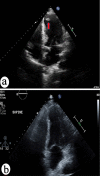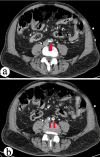Peripheral Embolization of Left Ventricular Thrombus Leading to Acute Bilateral Critical Limb Ischemia: A Rare Phenomenon
- PMID: 32256921
- PMCID: PMC7092770
- DOI: 10.14740/cr1030
Peripheral Embolization of Left Ventricular Thrombus Leading to Acute Bilateral Critical Limb Ischemia: A Rare Phenomenon
Abstract
Left ventricular thrombus (LVT) is a well-known complication of myocardial infarction (MI) leading to significant morbidity and mortality. LVT can also lead to systemic thromboembolic events causing threatening limb ischemia. We report a rare case of critical bilateral limb ischemia that resulted from peripheral embolization of LVT post MI, which was managed successfully by emergent surgical intervention and anticoagulation. A 74-year-old male with a medical history of hypertension, diabetes, hyperlipidemia and coronary artery disease status post stenting of the left anterior descending and left circumflex arteries presented to the emergency department with typical chest pain and progressive shortness of breath. Cardiac troponin levels on admission were 35 ng/mL of blood. The patient subsequently underwent emergent cardiac catheterization which revealed significant triple vessel disease, and was referred for coronary artery bypass grafting (CABG) surgery. Transthoracic and transesophageal echocardiograms revealed the presence of an apical aneurysm with chronic organized mobile thrombus at the apex. Post CABG, the patient complained of excruciating right leg pain. Computed tomography (CT) angiogram of the abdominal aorta and lower extremities revealed a large embolus at the aortic bifurcation occluding the right and nearly occluding the left common iliac arteries and thrombus in the right popliteal artery. He underwent emergent vascular surgery with resolution of his symptoms and remained without further complications. The incidence of LVT remains high in post-MI patients, and complications of LVT are known to include thromboembolic events. Peripheral embolization of acute or chronic LVT leading to bilateral distal embolization and critical limb ischemia remains a rare occurrence. This case report aims to aid clinicians to recognize and promptly manage LVT and related arterial thromboembolic events with anticoagulation and emergent surgical intervention if limb ischemia develops.
Keywords: Ischemia; Myocardial infarction; Peripheral embolization; Thromboembolism; Ventricular thrombus.
Copyright 2020, Agarwal et al.
Conflict of interest statement
The authors declare no conflicts of interest for this publication.
Figures



Similar articles
-
Case report: Oral anticoagulant combined with percutaneous coronary intervention for peripheral embolization of left ventricular thrombus caused by myocardial infarction in a patient with diabetes mellitus.Front Cardiovasc Med. 2022 Dec 8;9:1019945. doi: 10.3389/fcvm.2022.1019945. eCollection 2022. Front Cardiovasc Med. 2022. PMID: 36568554 Free PMC article.
-
Successful surgical transmitral removal of left ventricular thrombus after acute anterior myocardial infarction without left ventriculotomy.J Cardiol Cases. 2020 Sep 4;23(1):24-26. doi: 10.1016/j.jccase.2020.08.007. eCollection 2021 Jan. J Cardiol Cases. 2020. PMID: 33437336 Free PMC article.
-
Incidence and Predictors of Left Ventricular (LV) Thrombus after ST-Elevation Myocardial Infarction (STEMI) in the Holy Capital of Saudi Arabia.J Saudi Heart Assoc. 2021 Apr 30;33(2):101-108. doi: 10.37616/2212-5043.1243. eCollection 2021. J Saudi Heart Assoc. 2021. PMID: 34183905 Free PMC article.
-
Management of left ventricular thrombus: a narrative review.Ann Transl Med. 2021 Mar;9(6):520. doi: 10.21037/atm-20-7839. Ann Transl Med. 2021. PMID: 33850917 Free PMC article. Review.
-
Popliteal artery aneurysms. Factors associated with thromboembolism and graft failure.Int Angiol. 2004 Mar;23(1):54-65. Int Angiol. 2004. PMID: 15156131 Review.
Cited by
-
Acute Brachial Artery Occlusion on Point-of-Care Ultrasound in the Emergency Department: A Case Report.Clin Pract Cases Emerg Med. 2022 Nov;6(4):302-304. doi: 10.5811/cpcem.2022.9.57482. Clin Pract Cases Emerg Med. 2022. PMID: 36427028 Free PMC article.
-
Role of POCUS in Assessing an Acute Aortic Thrombus.POCUS J. 2023 Nov 27;8(2):129-131. doi: 10.24908/pocus.v8i2.16480. eCollection 2023. POCUS J. 2023. PMID: 38099158 Free PMC article.
-
Point-of-Care Ultrasound Diagnosis of Left Ventricular Thrombus: A Case Series.Cureus. 2025 Jul 2;17(7):e87192. doi: 10.7759/cureus.87192. eCollection 2025 Jul. Cureus. 2025. PMID: 40755678 Free PMC article.
-
ST-Elevation Myocardial Infarction Presenting as Acute Limb Ischemia.Cureus. 2020 Sep 13;12(9):e10432. doi: 10.7759/cureus.10432. Cureus. 2020. PMID: 33062545 Free PMC article.
References
-
- Driesman A, Hyder O, Lang C, Stockwell P, Poppas A, Abbott JD. Incidence and predictors of left ventricular thrombus after primary percutaneous coronary intervention for anterior ST-segment elevation myocardial infarction. Clin Cardiol. 2015;38(10):590–597. doi: 10.1002/clc.22450. - DOI - PMC - PubMed
Publication types
LinkOut - more resources
Full Text Sources
Miscellaneous
